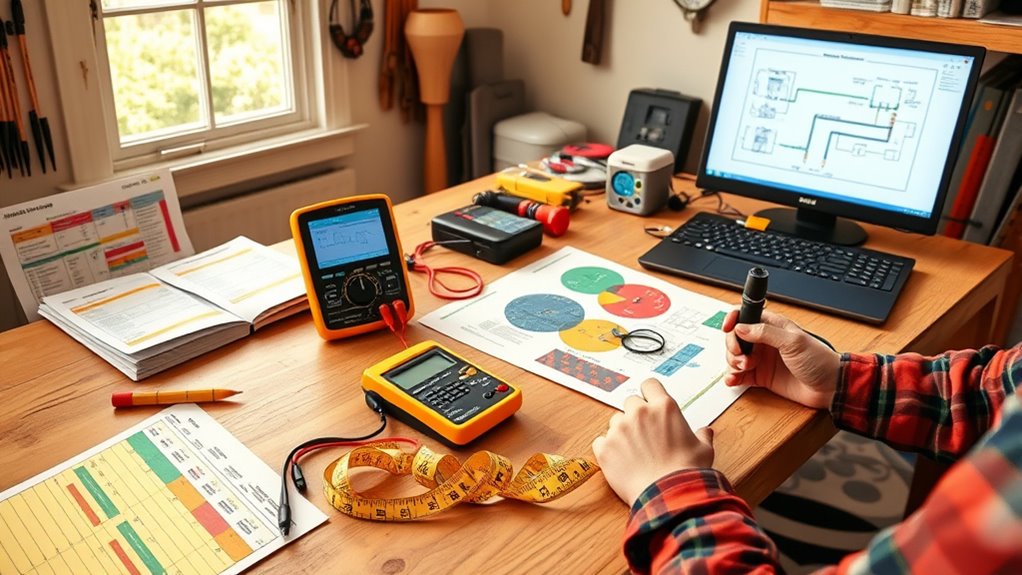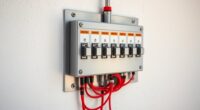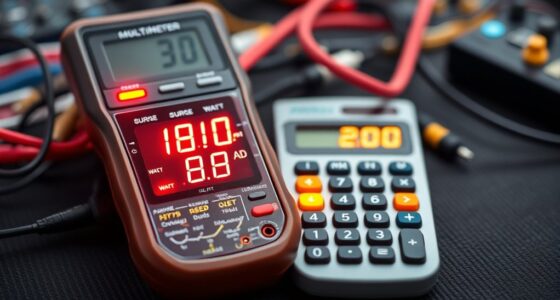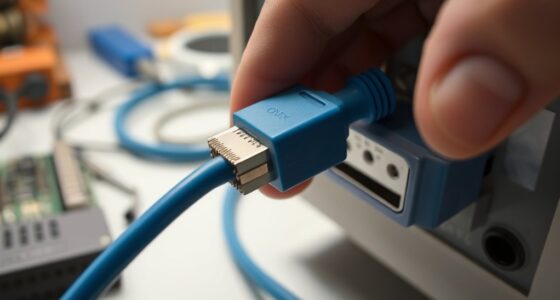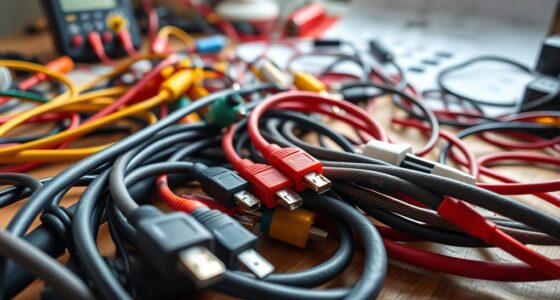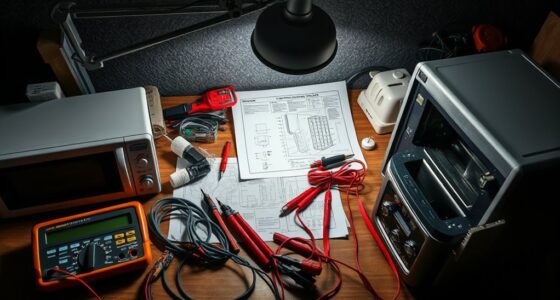To master wattage planning for your appliances in a weekend, start by understanding basic electrical terms like wattage, voltage, and current. Check labels or manuals to note each appliance’s wattage, then add up their total power needs. Create a power budget by setting limits on high-energy devices and prioritize usage accordingly. Use simple tools like energy meters and smart apps to monitor your consumption and keep refining your plan. Continue exploring for more tips to optimize your energy use.
Key Takeaways
- Learn to read appliance labels for wattage, voltage, and amperage details to understand power needs.
- Calculate total household wattage by summing appliance ratings, adding a safety margin for future expansion.
- Prioritize high-wattage devices and schedule their use during off-peak times to prevent overloads.
- Use energy management tools like smart meters and apps to monitor consumption and identify inefficiencies.
- Regularly review and adjust your wattage plan based on usage data to optimize safety and energy efficiency.
Understanding Basic Electrical Terms and Units
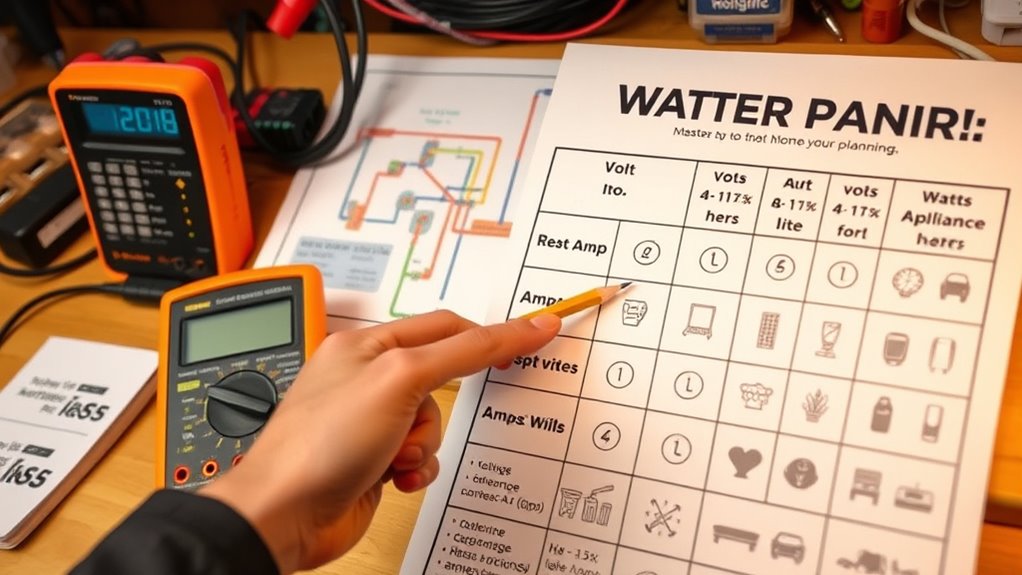
To understand wattage planning for appliances, you first need to grasp some basic electrical terms and units. Wattage measures how much power an appliance uses, which helps you determine if your electrical wiring can handle it. When considering solar power systems, knowing wattage is vital for sizing panels and batteries correctly. Voltage indicates the potential difference that drives electrical current, while amperes show how much current flows through the wiring. Power ratings on appliance labels tell you their energy needs. Understanding these units guarantees your electrical wiring can safely support your appliances without overloads. Additionally, understanding electrical load management is crucial to prevent circuit overloads and ensure safe operation. If you’re planning to integrate solar power, accurate wattage calculations help optimize your system’s efficiency and safety, ensuring your setup meets your energy demands reliably.
Identifying Wattage on Appliance Labels and Manuals
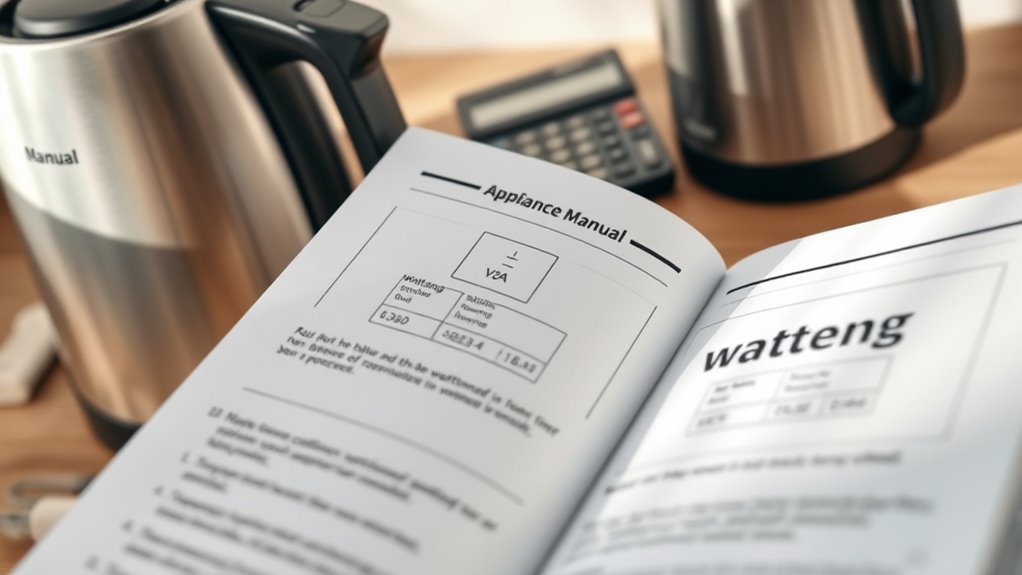
When you look at an appliance label or manual, the wattage information is usually clearly displayed to help you understand its power consumption. On the appliance label, you’ll often see a number followed by “W”—this indicates the wattage. The label may also include other details like voltage and amperage, but wattage is key for planning. In the manual specifications section, wattage is typically listed alongside other technical data. Be sure to check both sources if available, as labels are often attached directly on the appliance, while manuals provide more detailed information. Recognizing this information makes it easier to compare appliances and ensure your electrical system can handle their power requirements. Accurate wattage reading is crucial for safe electrical planning, especially when incorporating multiple devices into a single circuit. This step is essential for accurate wattage planning.
Calculating Total Power Consumption for Your Home

Understanding your home’s total power consumption is essential for safe and efficient electrical planning. To calculate this, start by adding up the wattage of all your appliances, which you’ve identified earlier. Remember, the power factor influences actual energy use; appliances with a low power factor draw more current than their wattage suggests. When summing your total load, consider how each appliance’s power factor impacts the circuit’s current draw. This helps determine the appropriate circuit breaker size, ensuring it can handle the combined load without tripping. Always account for surge or startup currents, especially for motors or refrigerators. By accurately calculating your total power consumption, you’ll ensure your electrical system is safe, efficient, and capable of supporting all your appliances without overloads. Additionally, understanding how Chevrolet Tuning techniques optimize engine performance can inspire ways to improve your home’s energy efficiency through smarter appliance choices and configurations.
Creating a Power Budget: Setting Your Appliance Limits

To create an effective power budget, you need to assess your total energy needs first. Then, focus on high-energy devices to set clear limits and prevent overloads. Don’t forget to include safe power margins to keep your system running smoothly and avoid surprises. Additionally, understanding the power consumption insights of your appliances can help you make more informed decisions about energy use and efficiency.
Assess Total Power Needs
Before you set limits on your appliances, you need to determine their total power consumption. This helps you create an accurate power budget and guarantees safe operation. Start by listing all appliances you plan to use regularly. Then, for each device, find the wattage rating usually printed on the label or in the manual. Finally, add up these wattages to get your total power need. Here are some tips:
- Regular appliance maintenance prevents overloading and keeps devices running efficiently.
- Use a power surge protection device to guard against voltage spikes that could damage your appliances.
- Keep track of your total wattage to avoid exceeding your circuit’s capacity, reducing fire risks and ensuring safe operation.
- Incorporating efficient heating solutions like wood-burning stoves can also help manage overall energy consumption and costs.
This process helps you plan effectively and maintain a safe, reliable power setup.
Prioritize High-Energy Devices
When creating a power budget, you should start by prioritizing your high-energy devices. These are the appliances that consume the most wattage, like refrigerators, air conditioners, or electric water heaters. Identifying these helps you understand your maximum power draw and guarantees your electrical wiring can handle the load safely. If you’re considering solar power, knowing which devices use the most energy allows you to optimize your system capacity. Focus on integrating high-energy appliances first into your wiring plan, ensuring circuits can support their wattage without overloads. This approach prevents overloading your system and helps plan for future expansion. Additionally, understanding comfort and support solutions can guide you in selecting appliances that improve your overall well-being while optimizing energy use. By managing high-energy devices upfront, you set a clear foundation for a reliable, efficient power setup that aligns with your energy sources and electrical infrastructure.
Allocate Safe Power Margins
Establishing safe power margins is essential to guarantee your electrical system remains reliable. By adding a buffer, you prevent overloads and reduce the risk of damage during power surges. To do this effectively:
- Allocate about 20-25% extra capacity beyond your total appliance wattage to account for potential power surges and future additions.
- Avoid running multiple high-wattage devices simultaneously, which can threaten electrical safety.
- Regularly review and adjust your power budget as you add or remove appliances, ensuring your system stays within safe limits.
- Understanding power management techniques helps optimize your electrical system and prevent overloads.
This approach helps protect your wiring and devices, minimizing risks associated with power surges and overloads. Properly allocating safe power margins keeps your home safe and your appliances functioning ideally.
Prioritizing and Planning Your Appliance Usage

Prioritizing and planning your appliance usage guarantees you make the most efficient use of your wattage capacity. Start by considering appliance placement, ensuring high-wattage devices are positioned for maximum use without overloading circuits. Always check voltage compatibility to prevent damage or inefficiency—using appliances suited for your home’s voltage ensures safe operation. Schedule heavy-duty appliances during off-peak times or when other devices aren’t in use to balance electrical load. Grouping similar appliances can help streamline power management and avoid surges. Keep a list of your devices’ wattage ratings and plan their usage accordingly. Incorporating protective styling benefits from techniques like crochet styles for locs can also help reduce the overall power consumption of hair appliances. By staying organized and mindful of placement and voltage requirements, you’ll optimize your wattage plan and prevent unnecessary power strain on your system.
Using Tools and Apps to Track Power Usage
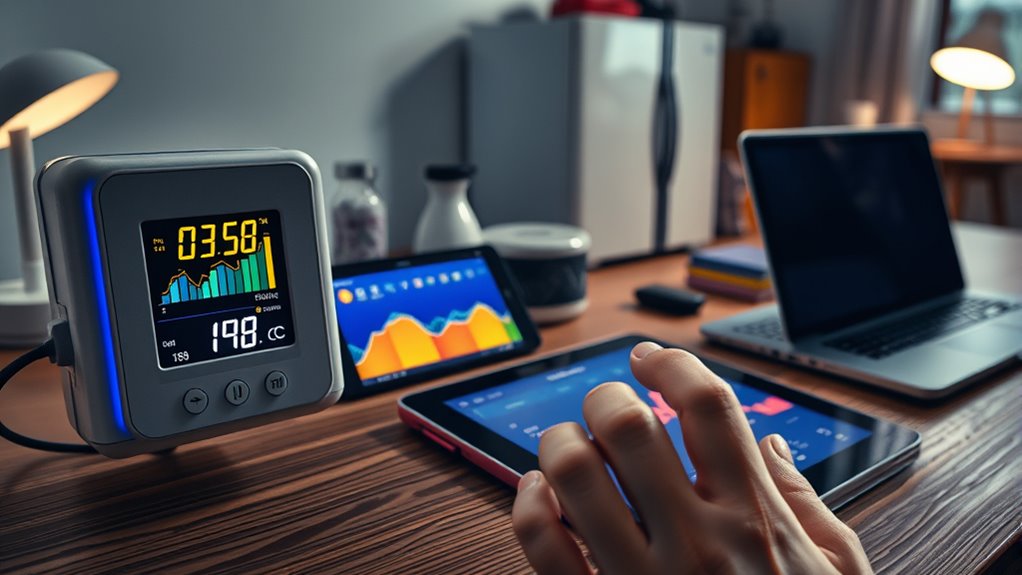
Utilizing tools and apps to track your power usage makes managing your electrical system more straightforward and accurate. These tools help you monitor how much energy your appliances consume, which can extend their lifespan and prevent costly power surges. To get started:
Tracking your energy use with tools and apps simplifies management and extends appliance lifespan.
- Use smart energy meters to measure real-time power consumption and identify high-usage appliances.
- Download energy management apps that log usage patterns, helping you optimize appliance operation.
- Set alerts for unusual spikes in power, reducing the risk of power surges damaging your devices.
- Consider using vetted home theatre projectors that are energy-efficient to further reduce electrical load and improve performance.
Implementing Efficiency Tips to Reduce Energy Consumption

Switching to energy-efficient devices can considerably cut your energy bills. Remember to unplug appliances when you’re not using them to prevent unnecessary power drain. These simple steps make a big difference in reducing your overall energy consumption. Using vetted appliances ensures you are investing in reliable and efficient options that contribute to energy savings.
Use Energy-Efficient Devices
Choosing energy-efficient devices is one of the most effective ways to cut down on your electricity bills. Upgrading to LED bulbs, ENERGY STAR appliances, and smart thermostats can considerably reduce energy use. These devices often consume less power while maintaining performance. Consider integrating solar power solutions to harness renewable energy, lowering reliance on traditional electricity sources. When selecting appliances, look for those with high efficiency ratings to maximize savings and support sustainability. Using energy-efficient devices not only saves money but also contributes to environmental conservation. By making smarter choices now, you set the foundation for a more energy-conscious home that benefits your budget and the planet. Small changes like these can make a big difference over time.
Unplug Idle Appliances
While upgrading to energy-efficient devices helps reduce overall power consumption, many appliances continue to draw electricity even when they’re not in use. To cut down on this wasted energy, unplug idle appliances whenever possible. Using a smart plug allows you to turn devices off remotely or set schedules, preventing phantom loads. For appliances with different voltage requirements, a voltage converter can help optimize power usage and protect your devices. These simple actions can considerably lower your energy bills and extend appliance lifespan. If unplugging isn’t convenient, smart plugs provide a practical alternative, ensuring devices are powered down when not needed. Remember, small adjustments like these contribute greatly to effective wattage planning and a more energy-conscious home.
Making Informed Choices When Buying New Appliances

When buying new appliances, making informed choices about wattage can guarantee you money and secure your home runs efficiently. First, always check the energy labels to compare wattage and efficiency ratings, helping you select models that save on energy conservation strategies. Second, consider appliance maintenance needs; choosing durable, energy-efficient options can prolong lifespan and reduce electricity use. Third, think about your household’s actual needs—avoid oversized appliances that consume unnecessary power. By doing this, you’ll prevent overspending and ensure your appliances operate at ideal wattage. Remember, smarter purchases now lead to long-term cost savings and a more sustainable home. Being intentional about wattage when shopping supports energy conservation and keeps your energy bills manageable.
Setting Up a Simple Monitoring System for Ongoing Management
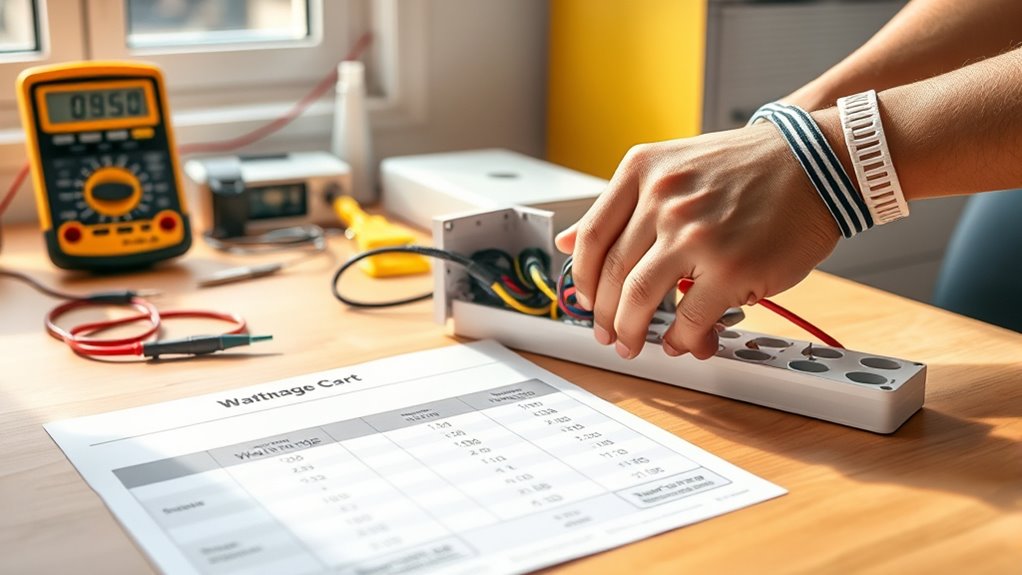
Setting up a simple monitoring system allows you to track your appliances’ energy use in real-time, helping you identify inefficiencies and prevent waste. Start by installing a smart meter on your main electrical panel or individual devices. This device provides accurate data on how much energy each appliance consumes. Next, connect the smart meter to an energy dashboard—either a dedicated app or a web platform—that displays your energy data clearly. With this setup, you can easily monitor usage patterns, recognize appliances that consume excessive power, and make informed adjustments. Keep an eye on your dashboard regularly to spot trends and optimize wattage planning. This ongoing management helps guarantee your appliances run efficiently while keeping your energy costs in check.
Reviewing and Adjusting Your Wattage Plan Over Time
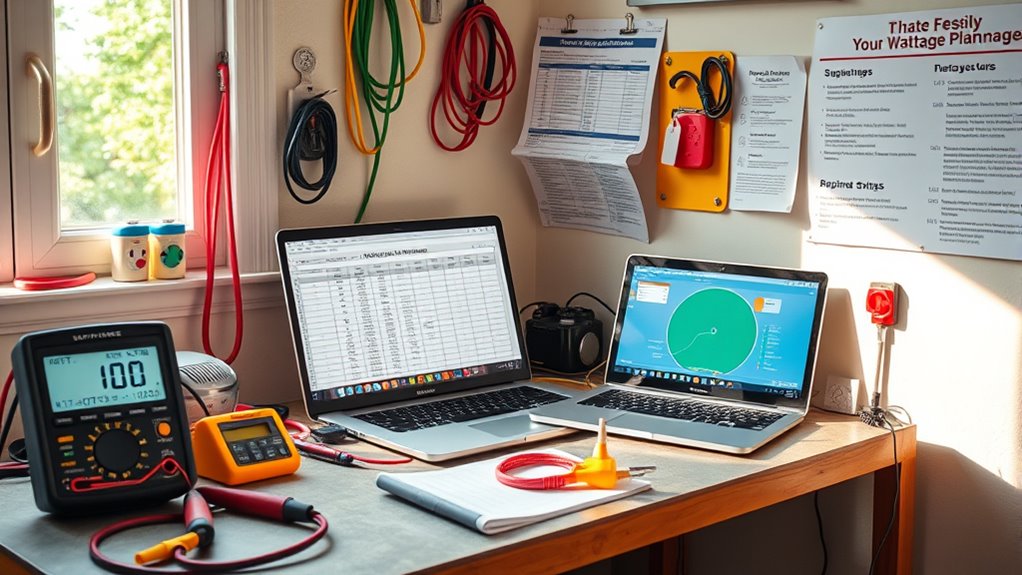
Regularly checking your energy use helps you stay on track with your wattage plan. If you add or remove appliances, you’ll need to modify your wattage calculations accordingly. Keeping your plan updated ensures your energy management remains effective over time.
Regularly Monitor Energy Use
Monitoring your energy use consistently allows you to identify patterns and spot inefficiencies in your wattage plan. By tracking your energy consumption regularly, you can see which appliances use the most power and adjust accordingly to save costs. This helps prevent overloading circuits and extends your appliance lifespan. To stay on top of your plan:
- Review your energy bills and usage data monthly to spot trends.
- Use smart meters or energy monitors for real-time insights.
- Adjust wattage settings or usage schedules based on your findings.
Regular monitoring keeps your wattage plan optimized, ensuring you’re not wasting energy or stressing appliances unnecessarily. Over time, this proactive approach helps maintain efficiency and prolongs the lifespan of your appliances, saving you money and hassle.
Adjust for Appliance Changes
As your household changes or new appliances are added, it’s essential to review and adjust your wattage plan accordingly. When introducing new devices, check their wattage to make sure they’re compatible with your existing system. Appliance compatibility depends on understanding each device’s wattage and how it fits within your total power capacity. If you add high-wattage appliances, you may need to reallocate or upgrade your wiring and circuit breakers to prevent overloads. Regularly reviewing your device wattage helps you avoid surprises and guarantees safe operation. Keep track of any changes and update your wattage plan to reflect the current appliance lineup. This proactive approach maintains efficiency, prevents electrical hazards, and keeps your household running smoothly.
Frequently Asked Questions
How Often Should I Review or Update My Wattage Plan?
You should review your wattage plan at least every six months, or whenever you add new appliances or notice changes in energy use. Regular wattage reviews help you identify potential overloads and guarantee your plan stays accurate. Schedule plan updates promptly whenever your household or appliance needs change. Staying proactive with plan updates keeps your energy management efficient and prevents unexpected electrical issues, making your home safer and more cost-effective.
Can I Use Wattage Planning to Lower My Electricity Bill?
Did you know that proper wattage planning can reduce your energy use by up to 20%? Yes, you can use wattage planning to lower your electricity bill. By selecting energy-efficient appliances and managing their wattage, you’ll see significant energy savings and cost reduction. It helps you identify which devices consume the most power, so you can optimize usage, cut costs, and make smarter, budget-friendly decisions for your home.
Are There Safety Concerns When Managing Appliance Wattage?
Yes, there are safety concerns when managing appliance wattage. You should always follow safety precautions like unplugging devices before adjusting wattage settings and avoiding overloading circuits. Be aware of electrical hazards such as sparks or overheating, which can cause fires or shocks. Use proper tools and seek professional help if you’re unsure about handling electrical components. Staying cautious helps prevent accidents and guarantees your home’s electrical safety.
How Do I Balance Appliance Performance With Energy Efficiency?
You can balance appliance performance with energy efficiency by choosing models that optimize energy consumption without sacrificing power. Always check appliance compatibility with your electrical system to prevent overloads. Adjust settings for energy-saving modes when possible, and prioritize appliances with higher efficiency ratings. This way, you enjoy reliable performance while reducing energy costs, and you won’t worry about safety or compatibility issues disrupting your daily routine.
What Are Common Mistakes to Avoid in Wattage Planning?
Avoid common wattage planning mistakes like appliance overload, which can trip breakers or cause damage, and overlooking faulty wiring that risks electrical fires. You should always check the wattage capacity of your circuits and match appliances accordingly. Don’t ignore the importance of proper wiring or underestimate power needs. Staying vigilant helps prevent dangerous overloads and ensures your appliances operate smoothly and safely.
Conclusion
Mastering wattage planning is like tuning your home’s energy orchestra—you become the conductor, ensuring every appliance plays its part without overwhelming the system. With a little practice, you’ll navigate your power needs effortlessly, turning energy management into a smooth, harmonious dance. Keep refining your plan as you learn, and soon, you’ll enjoy a more efficient, cost-effective home—like a well-oiled machine running in perfect sync.
